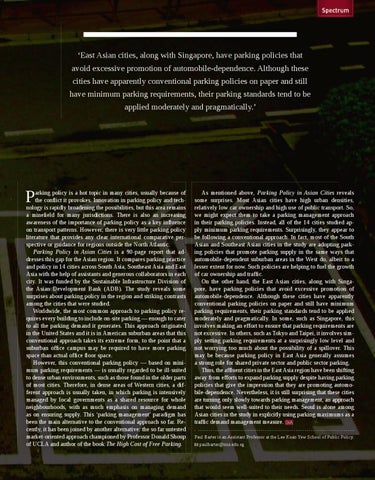‘East Asian cities, along with Singapore, have parking policies that avoid excessive promotion of automobile-dependence. Although these cities have apparently conventional parking policies on paper and still have minimum parking requirements, their parking standards tend to be applied moderately and pragmatically.’
P
arking policy is a hot topic in many cities, usually because of the conflict it provokes. Innovation in parking policy and technology is rapidly broadening the possibilities, but this area remains a minefield for many jurisdictions. There is also an increasing awareness of the importance of parking policy as a key influence on transport patterns. However, there is very little parking policy literature that provides any clear international comparative perspective or guidance for regions outside the North Atlantic. Parking Policy in Asian Cities is a 90-page report that addresses this gap for the Asian region. It compares parking practice and policy in 14 cities across South Asia, Southeast Asia and East Asia with the help of assistants and generous collaborators in each city. It was funded by the Sustainable Infrastructure Division of the Asian Development Bank (ADB). The study reveals some surprises about parking policy in the region and striking contrasts among the cities that were studied. Worldwide, the most common approach to parking policy requires every building to include on-site parking — enough to cater to all the parking demand it generates. This approach originated in the United States and it is in American suburban areas that this conventional approach takes its extreme form, to the point that a suburban office campus may be required to have more parking space than actual office floor space. However, this conventional parking policy — based on minimum parking requirements — is usually regarded to be ill-suited to dense urban environments, such as those found in the older parts of most cities. Therefore, in dense areas of Western cities, a different approach is usually taken, in which parking is intensively managed by local governments as a shared resource for whole neighbourhoods, with as much emphasis on managing demand as on ensuring supply. This ‘parking management’ paradigm has been the main alternative to the conventional approach so far. Recently, it has been joined by another alternative: the so far untested market-oriented approach championed by Professor Donald Shoup of UCLA and author of the book The High Cost of Free Parking.
As mentioned above, Parking Policy in Asian Cities reveals some surprises. Most Asian cities have high urban densities, relatively low car ownership and high use of public transport. So, we might expect them to take a parking management approach in their parking policies. Instead, all of the 14 cities studied apply minimum parking requirements. Surprisingly, they appear to be following a conventional approach. In fact, most of the South Asian and Southeast Asian cities in the study are adopting parking policies that promote parking supply in the same ways that automobile-dependent suburban areas in the West do, albeit to a lesser extent for now. Such policies are helping to fuel the growth of car ownership and traffic. On the other hand, the East Asian cities, along with Singapore, have parking policies that avoid excessive promotion of automobile-dependence. Although these cities have apparently conventional parking policies on paper and still have minimum parking requirements, their parking standards tend to be applied moderately and pragmatically. In some, such as Singapore, this involves making an effort to ensure that parking requirements are not excessive. In others, such as Tokyo and Taipei, it involves simply setting parking requirements at a surprisingly low level and not worrying too much about the possibility of a spillover. This may be because parking policy in East Asia generally assumes a strong role for shared private sector and public sector parking. Thus, the affluent cities in the East Asia region have been shifting away from efforts to expand parking supply despite having parking policies that give the impression that they are promoting automobile-dependence. Nevertheless, it is still surprising that these cities are turning only slowly towards parking management, an approach that would seem well-suited to their needs. Seoul is alone among Asian cities in the study in explicitly using parking maximums as a traffic demand management measure. Paul Barter is an Assistant Professor at the Lee Kuan Yew School of Public Policy. paulbarter@nus.edu.sg
